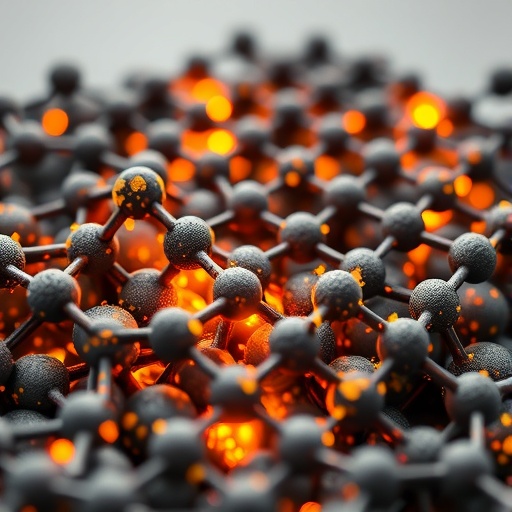In recent years, the pursuit of efficient materials for environmental remediation has gathered substantial momentum. One particularly prominent area of research is the removal of heavy metal ions from contaminated water sources. Heavy metals, such as lead, mercury, cadmium, and chromium, pose significant threats to both human health and ecosystems. The complexity of removing these metals effectively has prompted countless studies aimed at developing novel materials that can tackle this global challenge. A groundbreaking study by Salari and Masoudi, set to be published in the journal Ionics, unveils an innovative approach that leverages advanced material synthesis to facilitate rapid and selective metal ion removal.
The study focuses on the fabrication of AMoO4 (where A denotes nickel, manganese, and cobalt) in conjunction with graphene oxide, a combination that promises remarkable efficiency and selectivity in the remediation of heavy metal ions. The researchers underscored the necessity for sustainable solutions in water purification, noting that conventional methods often fall short, either in efficiency or in environmental sustainability. The implications of their findings could reflect a considerable advancement in the field, offering both theoretical insights and practical applications for heavy metal ion removal.
Salari and Masoudi’s work builds on the well-documented capabilities of transition metal oxides as adsorbents. The AMoO4 compounds were selected due to their favorable properties, including tunable electronic structures and high surface areas, which significantly enhance adsorption processes. The study meticulously details the synthesis of these compounds, emphasizing the controlled fabrication techniques employed to achieve uniformity and optimal functionality. This level of detail allows for reproducibility and further exploration by other researchers in the field.
The incorporation of graphene oxide into the composite structure is similarly ingenious. Graphene oxide, known for its exceptional surface area, mechanical strength, and electrical conductivity, serves to enhance the overall performance of the AMoO4 composites. The synergistic effect of combining these materials not only improves adsorption kinetics but also achieves selectivity towards specific heavy metal ions. This selectivity is a key consideration in the field of wastewater treatment, where the simultaneous presence of various contaminants complicates the remediation processes.
Preliminary results presented in the paper indicate that the AMoO4-graphene oxide composites exhibit rapid adsorption rates for targeted heavy metals, with impressive efficiencies being noted in batch experiments. The researchers conducted a series of experiments to evaluate the kinetics and thermodynamics of the adsorption process, binding affinities, and the maximum adsorption capacities of the new composite materials. These experiments reveal that the innovative materials are capable of not only selectively targeting heavy metal ions but also efficiently binding them in a wide range of concentrations.
The study further explores the mechanisms behind the adsorption process. Advanced characterization techniques, including Fourier-transform infrared spectroscopy (FTIR), scanning electron microscopy (SEM), and X-ray diffraction (XRD) analyses, were employed to elucidate the interactions between the heavy metal ions and the composite materials. The data obtained from these methods provide critical insights into the pathways of ion removal, laying the foundation for future modifications and optimizations of the materials.
One of the most promising aspects of this research is the scalability potential of the AMoO4-graphene oxide composites. The authors discuss the feasibility of translating their lab-scale findings into industrial applications. They advocate for the design of cost-effective materials that maintain high efficiency, positioning their work as a solution that could be implemented in real-world water treatment facilities. Such advancements are crucial for addressing growing concerns regarding water quality around the globe, particularly in regions heavily impacted by industrial pollution.
The environmental implications of successful heavy metal ion removal are profound. Beyond safeguarding public health, the ability to mitigate heavy metal contamination significantly contributes to ecosystem preservation. This line of research holds promise not only for dealing with current pollution levels but also for preventing future contamination scenarios. The prioritization of environmentally friendly materials that minimize toxic byproducts in the remediation process aligns with broader sustainability goals.
As the research leads to future explorations, it is essential to consider the adaptability of these materials to various types of wastewater. Different industrial processes introduce a range of contaminants; therefore, assessing the effectiveness of AMoO4-graphene oxide composites in varied environments will be critical. Salari and Masoudi underscore the importance of continuing innovation within the material science discipline, where tailored solutions can emerge to address diverse and complex water quality challenges.
In conclusion, Salari and Masoudi’s work represents a significant step forward in the ongoing search for effective methods of heavy metal ion removal. The elegant combination of AMoO4 compounds with graphene oxide resulted in a material that not only performs efficiently but also demonstrates selectivity, paving the way for its application in real-world scenarios. This research encapsulates the revolutionary potential of nanomaterials in environmental science, with far-reaching implications for public health and ecological sustainability.
The study’s findings encourage broader collaboration among material scientists, environmental engineers, and policymakers to promote the implementation of these advanced materials in existing and forthcoming wastewater treatment strategies. By translating such innovative research into practical applications, an urgent global issue like heavy metal contamination can be significantly mitigated, heralding a cleaner and safer future.
Subject of Research: Heavy Metal Ion Removal Using AMoO4-Graphene Oxide Composites
Article Title: Fabrication of AMoO4 (A: Ni, Mn and Co) coupled with graphene oxide for fast and selective removal of heavy metal ions.
Article References:
Salari, H., Masoudi, A. Fabrication of AMoO4 (A: Ni, Mn and Co) coupled with graphene oxide for fast and selective removal of heavy metal ions.
Ionics (2025). https://doi.org/10.1007/s11581-025-06828-7
Image Credits: AI Generated
DOI: 10.1007/s11581-025-06828-7
Keywords: Heavy Metals, Water Treatment, AMoO4, Graphene Oxide, Environmental Remediation.




